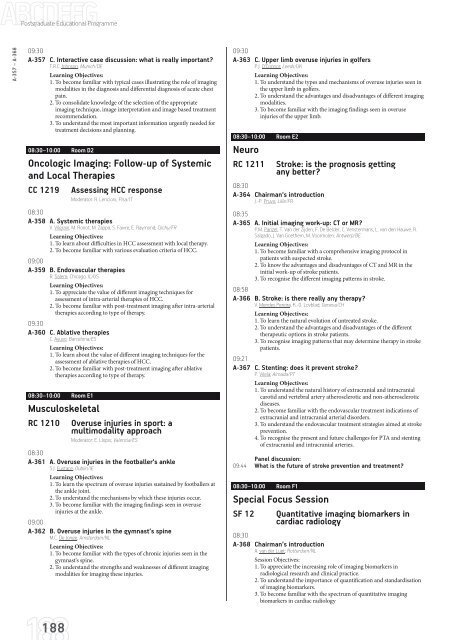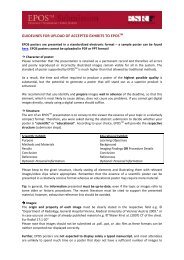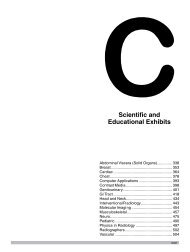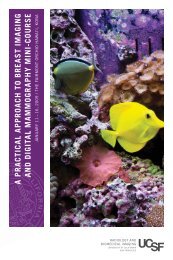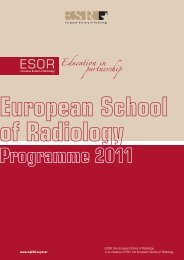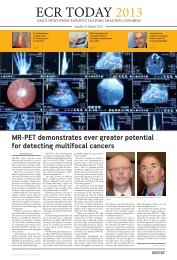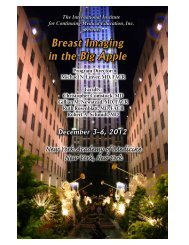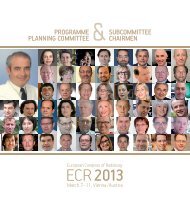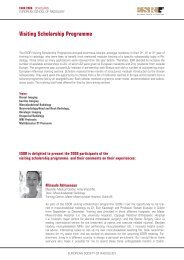ECR 2013 â Final Programme - myESR.org
ECR 2013 â Final Programme - myESR.org
ECR 2013 â Final Programme - myESR.org
- No tags were found...
You also want an ePaper? Increase the reach of your titles
YUMPU automatically turns print PDFs into web optimized ePapers that Google loves.
Postgraduate Educational <strong>Programme</strong>A-357 – A-36809:30A-357 C. Interactive case discussion: what is really important?T.R.C. Johnson; Munich/DELearning Objectives:1. To become familiar with typical cases illustrating the role of imagingmodalities in the diagnosis and differential diagnosis of acute chestpain.2. To consolidate knowledge of the selection of the appropriateimaging technique, image interpretation and image based treatmentrecommendation.3. To understand the most important information urgently needed fortreatment decisions and planning.08:30–10:00 Room D2Oncologic Imaging: Follow-up of Systemicand Local TherapiesCC 1219 Assessing HCC responseModerator: R. Lencioni; Pisa/IT08:30A-358 A. Systemic therapiesV. Vilgrain, M. Ronot, M. Zappa, S. Faivre, E. Raymond; Clichy/FRLearning Objectives:1. To learn about difficulties in HCC assessment with local therapy.2. To become familiar with various evaluation criteria of HCC.09:00A-359 B. Endovascular therapiesR. Salem; Chicago, IL/USLearning Objectives:1. To appreciate the value of different imaging techniques forassessment of intra-arterial therapies of HCC.2. To become familiar with post-treatment imaging after intra-arterialtherapies according to type of therapy.09:30A-360 C. Ablative therapiesC. Ayuso; Barcelona/ESLearning Objectives:1. To learn about the value of different imaging techniques for theassessment of ablative therapies of HCC.2. To become familiar with post-treatment imaging after ablativetherapies according to type of therapy.08:30–10:00 Room E1MusculoskeletalRC 1210 Overuse injuries in sport: amultimodality approachModerator: E. Llopis; Valencia/ES08:30A-361 A. Overuse injuries in the footballer‘s ankleS.J. Eustace; Dublin/IELearning Objectives:1. To learn the spectrum of overuse injuries sustained by footballers atthe ankle joint.2. To understand the mechanisms by which these injuries occur.3. To become familiar with the imaging findings seen in overuseinjuries at the ankle.09:00A-362 B. Overuse injuries in the gymnast‘s spineM.C. De Jonge; Amsterdam/NLLearning Objectives:1. To become familiar with the types of chronic injuries seen in thegymnast‘s spine.2. To understand the strengths and weaknesses of different imagingmodalities for imaging these injuries.09:30A-363 C. Upper limb overuse injuries in golfersP.J. O‘Connor; Leeds/UKLearning Objectives:1. To understand the types and mechanisms of overuse injuries seen inthe upper limb in golfers.2. To understand the advantages and disadvantages of different imagingmodalities.3. To become familiar with the imaging findings seen in overuseinjuries of the upper limb.08:30–10:00 Room E2NeuroRC 1211Stroke: is the prognosis gettingany better?08:30A-364 Chairman‘s introductionJ.-P. Pruvo; Lille/FR08:35A-365 A. Initial imaging work-up: CT or MR?P.M. Parizel, T. Van der Zijden, F. De Belder, C. Venstermans, L. van den Hauwe, R.Salgado, J. Van Goethem, M. Voormolen; Antwerp/BELearning Objectives:1. To become familiar with a comprehensive imaging protocol inpatients with suspected stroke.2. To know the advantages and disadvantages of CT and MR in theinitial work-up of stroke patients.3. To recognise the different imaging patterns in stroke.08:58A-366 B. Stroke: is there really any therapy?V. Mendes Pereira, K.-O. Lovblad; Geneva/CHLearning Objectives:1. To learn the natural evolution of untreated stroke.2. To understand the advantages and disadvantages of the differenttherapeutic options in stroke patients.3. To recognise imaging patterns that may determine therapy in strokepatients.09:21A-367 C. Stenting: does it prevent stroke?P. Vilela; Almada/PTLearning Objectives:1. To understand the natural history of extracranial and intracranialcarotid and vertebral artery atherosclerotic and non-atheroscleroticdiseases.2. To become familiar with the endovascular treatment indications ofextracranial and intracranial arterial disorders.3. To understand the endovascular treatment strategies aimed at strokeprevention.4. To recognise the present and future challenges for PTA and stentingof extracranial and intracranial arteries.Panel discussion:09:44 What is the future of stroke prevention and treatment?08:30–10:00 Room F1Special Focus SessionSF 12 Quantitative imaging biomarkers incardiac radiology08:30A-368 Chairman‘s introductionA. van der Lugt; Rotterdam/NLSession Objectives:1. To appreciate the increasing role of imaging biomarkers inradiological research and clinical practice.2. To understand the importance of quantification and standardisationof imaging biomarkers.3. To become familiar with the spectrum of quantitative imagingbiomarkers in cardiac radiology188


